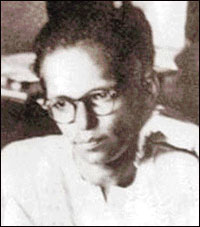|
VARIETY
The origin of
our National Anthem
The one day in the year when both the national flag and national
anthem are given a very prominent and important place is Independence
Day. Today I write some little known facts about our national anthem and
the man who composed it.Most of you readers must be aware as to who
composed our national anthem. It was Ananda Samarakoon.
On his return from Shantinikethan, Rabindranath Tagore's School of
Music and Dance, he set a new style both in the composition of songs and
in singing which were very different to the Tower Hall style then in
vogue in Ceylon. The songs were in simple every-day Sinhala and the
tunes appealing to the masses. Ananda Samarakoon has admitted that he
was greatly influenced by the Tagore school of music this was in the
late 1930s.
|

Ananda Samarakoon. |
It is on record that Namo Namo Matha - now Sri Lanka Matha - was
composed while he was a teacher at Mahinda Colege, Galle. T.D.
Jayasuriya then Chief Inspector of Schools for the Southern Province had
suggested to Samarakoon to compose a song that would inspire a feeling
of patriotism in the listeners. Namo Namo Matha was his response to
Jayasuriya's suggestion. He called it a Jatika Geeya national song.
Samarakoon has made a note in one of his books that he composed it in
October 1940.
This fact was stated in an article in the tabloid Nava Yugaya of Nov.
5, 1984. It was first sung in public before W. Dahanayaka, then Mayor of
Galle. He was accompanied by Elain de Silva with whom he had earlier
sung the duet Endada Menike. Two years later in 1942 he sang Namo Namo
Matha in a 'Sarala Gee' programme on Radio Ceylon. This time he was
accompanied by a pupil of his, Swarna de Silva who was then his partner
in singing duets. The song first appeared in print in 1943 in a book of
songs titled Kumudini with a foreword by T.D. Jayasuriya. Namo Namo
Matha and some other songs that Samarakoon sang with Swarna de Silva
were recorded by H.M.V. the gramaphone record company.
When was Namo Namo Matha officially adopted as our national
anthem?When we got independence in 1948 we did not have a national
anthem. Until then 'God Save the King', the national anthem of Britain
was played on ceremonial occasions, as we were a colony of the British
Empire. The need for a national anthem was felt strongly by the
Minister.At the end of 1948 a competition was held to select a national
anthem of our own. Many singers and musicians competed. Ananda
Samarakoon was away in India and knew nothing of the contest. His pupil
and singing partner, Swarna de Silva who was then an undergraduate in
the Colombo University, got together a few girls who could sing and got
them and herself trained by a professional, to sing Namo Namo Matha.
They entered the contest and sang Namo Namo Matha accompanied by
professional musicians like Tennyson Rodrigo, Patrick Rodrigo, and
Sarathsena (Chitrasena's brother). The judges selected this song as the
most appropriate song for a national anthem.The following year a group
of Musaeus College girls and Swarna de Silva sang Namo Namo Matha at the
Independence Day celebrations and it has been sung ever since on
Independence Day and at all ceremonial occasions.
Our national anthem too had been a popular song since the day it
first came over the air.Around the end of the 1950s various criticism
were levelled against the national anthem. Learned people both laymen
and Buddhist monks pointed out that the 'Gana', the combination of
letters in the opening words was inauspicious and should be changed.
After much debate Namo Namo Matha was changed to Sri Lanka Matha, in
1962.
This was a blow to the composer. He was depressed for days and weeks,
so depressed that he took an overdose of sleeping pills on the night of
April 2. He died on April 5.
This year 2011 marks the centenary of Ananda Samarakoon's birth. He
was born in January 1911 in Padukka in the Colombo district. His parents
were Christians, who registered the son as Egodege George William Alwis
Samarakoon, and sent him to Christian College, Kotte (now
Jayewardenepura Vidyalaya) for his education. In the mid 1930s he like
many young men in Ceylon, went to Shantinekethan, Tagore's School of
Music and dance. At the end of his training it was not George Wilfred
who returned to his homeland. It was Ananda Samarakoon.
- Sumana Saparamadu |

